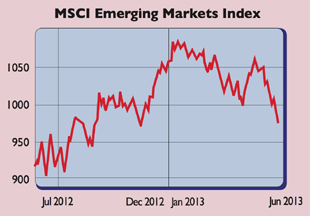
Emerging markets are “bleeding across the board”, says JPMorgan’s Sajjid Chinoy. Investors in emerging-market (EM) bonds have lost 5% this year. An index tracking EM currencies lost more than 3% in May, the biggest decline in a year.
The Indian rupee has slid to a record low against the dollar and the South African rand has lost 10% against the greenback in the past four weeks. Stocks have struggled too, unlike their developed-world counterparts. The MSCI Emerging Markets Index has fallen by 10% since early January; it lost over 4% in May.
So what’s going on? In the past decade EMs have flourished on the back of “fundamental fiscal and economic improvements”, says Robin Wigglesworth in the Financial Times. Economic reforms and improved management helped states boost growth and conquer debt. Average EM public debt is 33% of GDP. And returns on EM assets – along with other traditionally risky assets – have been “supercharged” by central-bank money-printing driving global risk appetite.
But now an eventual end to money printing by the US Federal Reserve, and a stronger US economy, are a possibility, while EM growth “has been quite disappointing” in recent months, notes Ruchir Sharma of Morgan Stanley Investment Management. “What started out as a China slowdown is now happening everywhere.”
Mexico is a noteworthy recent downward revision: it now expects growth of 3.1% in 2013, rather than 3.5%. Over the past few weeks, no fewer than six Asian central banks have cut interest rates. EM manufacturing is now shrinking marginally. The big markets, such as India, Brazil and Russia, have all slowed in recent years, and smaller success stories, such as the Philippines (whose equity market is on a trailing price/earnings ratio of 20) look pricey, adds Ben Levisohn in Barron’s.
Weaker growth also dents the appeal of EM bonds and currencies, while lower rates reduce the yield on these assets. Falling commodity prices, also a reflection of weaker growth, undermine Latin American currencies in particular. Meanwhile, yields on US assets are rising as investors factor in an end to Fed bond buying and better growth. The dollar index, measuring the greenback against a group of major trading partners’ currencies, reached a three-year high last month. EMs still look appealing for the long term, but investors have had a nasty reminder that they are hardly a one-way bet.